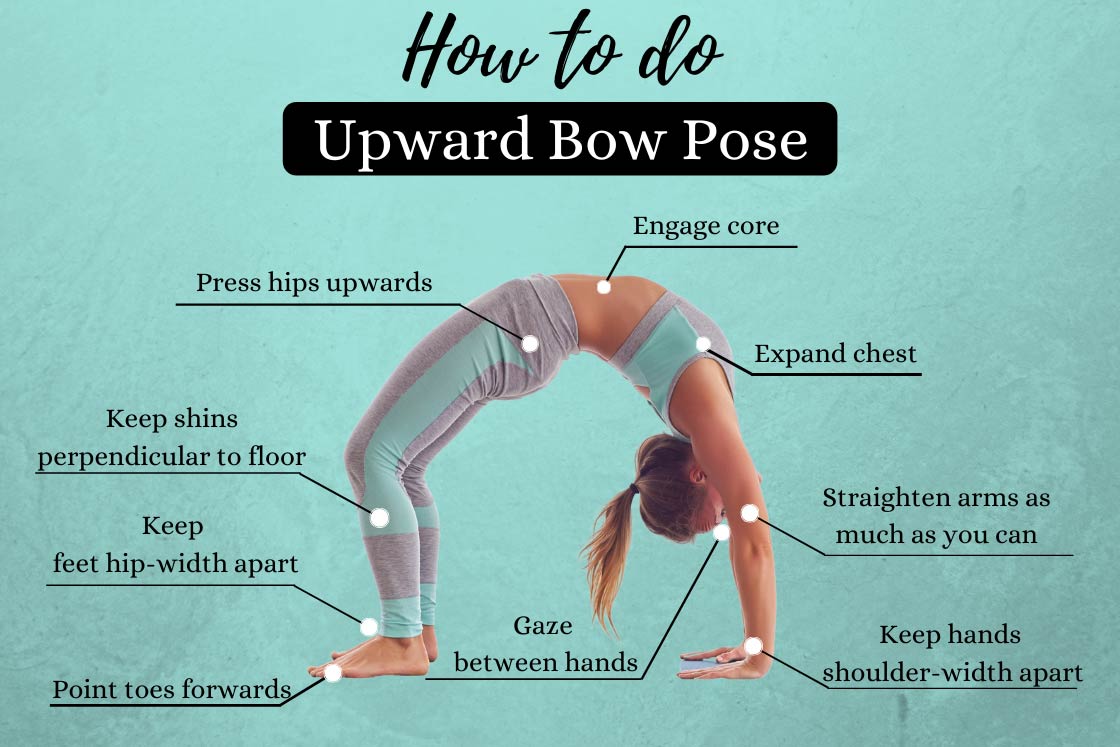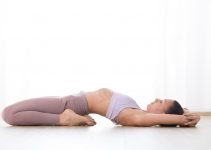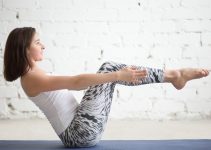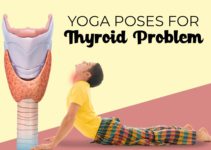
Image Source: Shutterstock
After performing Bow Pose, the turn comes to its advance version, which provides good stretch and nourishment to each muscle of the body. Unlike Bow Pose, it is done with lifting core upwards, instead of placing it on the floor. This asana is Upward Bow Pose or Urdhva Dhanurasana. Let’s know more about this asana.
Urdhva Dhanurasana: Upward Bow Pose
Upward Bow Pose is an intermediate level back-bending asana. Basically, it is a gentle inversion, that stretches the whole body, especially the spine and abdomen, and increases the overall flexibility and strength of the body.
This asana is very beneficial for those who sit in front of a desk or a computer for prolonged hours, as it removes tension and stress from their body.
Urdhva Dhanurasana is a part of the finishing sequence of Asthanga Vinyasa Yoga sequences. It is also done in the acrobatics & gymnastics and known as the name Back Bridge in these practices.
In Hatha Yoga, this posture is called Chakrasana or Wheel Pose, while in Ashtanga Vinyasa, it is called Urdhva Dhanurasana or Upward Bow Pose.
Like many other Yoga Asanas, the reason behind naming it Upward Bow Pose or Urdhva Dhanurasana is also the body structure you form while performing this asana.
When you perform Upward Bow Pose, your body resembles an upward-facing bow, floor as the string of bow and body as the body of the bow. Therefore we call it Upward Bow Pose or Urdhva Dhanurasana.
The same thing (body posture) is the reason behind naming it Chakrasana or Wheel Pose also. When you perform this asana, your body also seems like a wheel/chakra, therefore we also call it Wheel Pose/Chakrasana.
How to Perform Upward Bow Pose?

Performing Wheel Pose is not very hard. It just needs some strength and flexibility. You need to follow the following steps to perform this asana easily.
Preparing the Asana
- Firstly, lie flat on your back.
- Now, bring your feet close to your hip and place them flat on the floor, toes pointing forwards.
- Keep the feet hip-width apart and do not turn the knees out. Keep your heels right below your knees.
Here your shins will be exactly perpendicular to the floor.
- Now, fold your elbows and take your hands back by your ears. Keep the palms shoulder-width apart, fingertips pointing towards the feet.
- Align your elbows in line with your wrists. Do not let your elbows turn out.
Getting into the Pose
- Inhale, press your feet and lift your hips off the floor.
- Simultaneously, rotate the shoulders, press your palms and lift your torso off the floor.
Note- Here, at first, you have to lift your hips with lower back, then middle and upper back.
If you are a beginner, pause on your crown, before lifting the whole body. Place your crown on the floor, breath and check the alignment of the body. Then lift your whole torso and head off the floor
- Press your hips up towards the ceiling. Also, stretch your back and thighs as much as possible.
Make sure your knees are in line with the feet. Also, keep both shins parallel to each other.
- Extend your arms as much as possible and engage the core
- Gaze straight or gaze down between your hands. But, do not stretch the neck to lift the chin towards the chest.
Now start taking full, deep breaths and hold the position for 3-8 breaths (about 20-60 seconds).
Note- Form a structure like inverted “U”, not inverted “V”.
Releasing the Pose
When you are done, come out on the reverse way as you went in. Let’s see how.
- Firstly, bring the chin towards the chest.
- Now, fold the elbows slowly and land, on the floor, on your shoulders first.
- Simultaneously, lower the hips and bring your whole body down to the floor.
- Now, extend the legs and relax.
Props and Modification
- In the beginning, loop a yoga strap around your knees. This will help to prevent the legs from turning out. You can do the same with arms.
- Taking the help of a partner is a good idea. Ask your friend or instructor to help you to lift your body up. Also, ask him/her to maintain the alignment of your elbows as well as knees.
- You can place the yoga blocks under your palms to get extra support. You can even place the blocks on the wall at a 45degree angle and then place your hands on them.
- If you want to take this exercise to the next level, lift one leg straight towards the ceiling. Repeat this with both legs.
- If you want to stretch more, walk your feet towards your hands as much as you can.
As Upward Bow Pose is an intermediate level exercise, so you need to warm up your body before performing this asana, to prepare the body for this asana. So let’s see what are the preparatory poses for Upward Bow Pose.
Preparatory Poses
- Bridge Pose (Setu bandha Sarvangasana)
- Sun Salutation (Surya Namaskara) Sequence
- Cobra Pose (Bhujangasana)
Follow Up Pose
- Savasana (Corpse Pose)
- Supta Baddha Konasana (Reclining Bound Angle Pose)
Precautions and Contraindications
- Stretch your body according to its limits and capacity. Overstretching can cause you harm, so, do not overstretch your body.
- Do not release the asana with a jerk. Release it gently. Besides, do not perform it in a hurry. Do it slowly and smoothly.
- If you feel any type of muscle cramp or pain while performing this asana, release the asana immediately.
- If your muscles are stiff or you are not much flexible, so, at first, try some basic stretching yoga asana before performing this asana.
- Avoid this asana in any kind of recent or deep injury in the shoulder, back, arms, legs, core, and hips. Performing this asana in such conditions can cause you pain.
- When you are dealing with physical illnesses such as Carpal Tunnel Syndrome, high or low blood pressure, hernia, spinal inflammation or heart-related problems, do not perform this asana.
Benefits of Upward Bow Pose
Wheel Pose comes with tremendous benefits to the body and mind. It improves overall stretching and mobility of the body and gives a proper shape to the body. Here is a list of benefits of Upward Bow Pose.
- It removes all the issues and problems, which causes infertility from the prostate gland and the ovary. Thus, it helps in curing infertility, in both men and women.
- This asana puts a good amount of stretch on abdominal muscles. Thus, it tones the muscles and glands associated with the abdomen such as the pancreas, liver, kidneys, etc. This results in stimulating the digestion and detoxification of the body.
- Also, it stretches and exercises each and every muscle of the core and helps to reduce fat from the core.
- Upward Bow Pose stretches the hip flexors. This stretch tones the hip flexors and helps them to expand. Thus, it removes the stiffness and tightness from the hips.
- It tones each muscle of the shoulder and makes the shoulders strong and flexible.
- This asana opens the chest region and promotes the proper expansion of the diaphragm, resulting in good respiration. Thus, it improves the function of the respiratory system and gives a boost to breathing and the flow of Prana.
- Upward Bow Pose stretches vertebral columns and regulates a proper flow of blood to the whole spine. Thus, it nourishes the whole spine, elongates the lumbar spine, and increases its flexibility. It keeps the spine healthy and provides an overall flexible and strong back.
- Besides other major body muscles, this asana also stretches thighs, hamstrings, knees, feet, wrist, and arms. It massages these muscles, removes stiffness form them, and increases their mobility.
- Urdhva Dhanurasana is a heart opener asana that fills you with the sensations of joy and satisfaction. It will make you feel more positive, calm and patient.
- This asana soothes the central nervous system and provides you deep relaxation and calmness. Also, it removes negative emotions like anger, depression, etc.
Upward Bow Pose FAQs
What is upward Bow Pose good for?
Upward Bow Pose is good for curing infertility, indigestion, osteoporosis, backaches, menstrual cramps, and asthma. Also, it gives an overall stretch to the body from head to toe and provides a nice body shape.
Which body parts and muscles are focused on Upward Bow Pose?
Upward Bow Pose mainly focuses on the following body parts and muscles.
1. Arm and shoulders
2. Neck and chest
3. Core and Back
4. Hamstrings and thighs
5. Knees and hips




